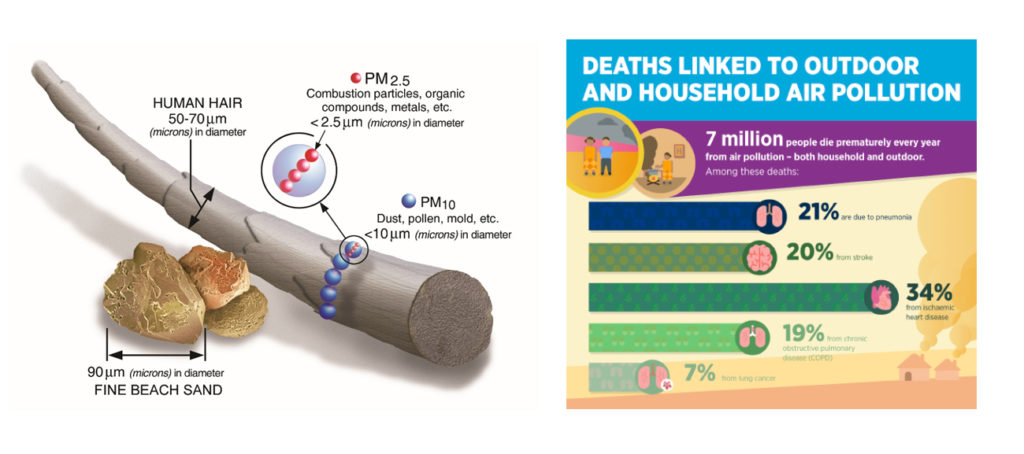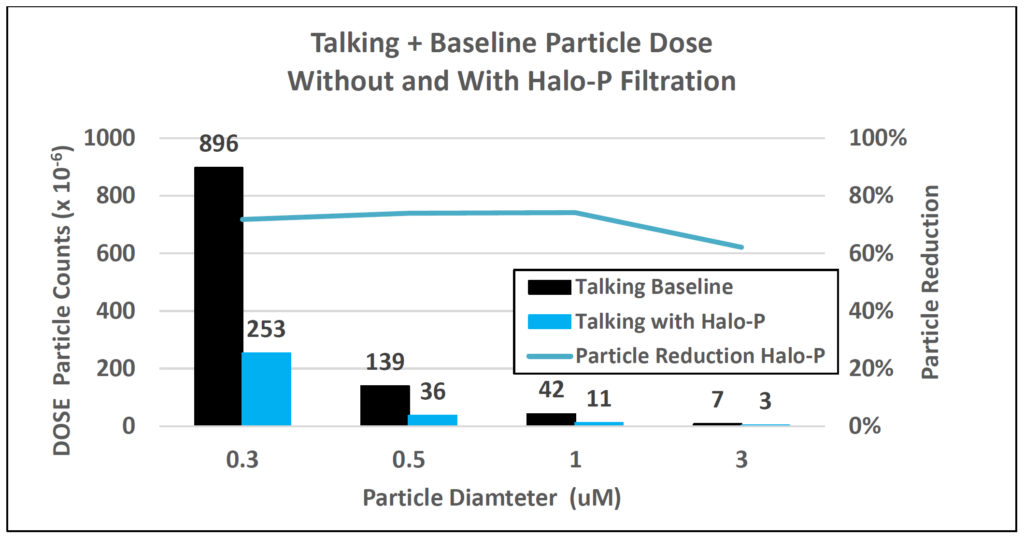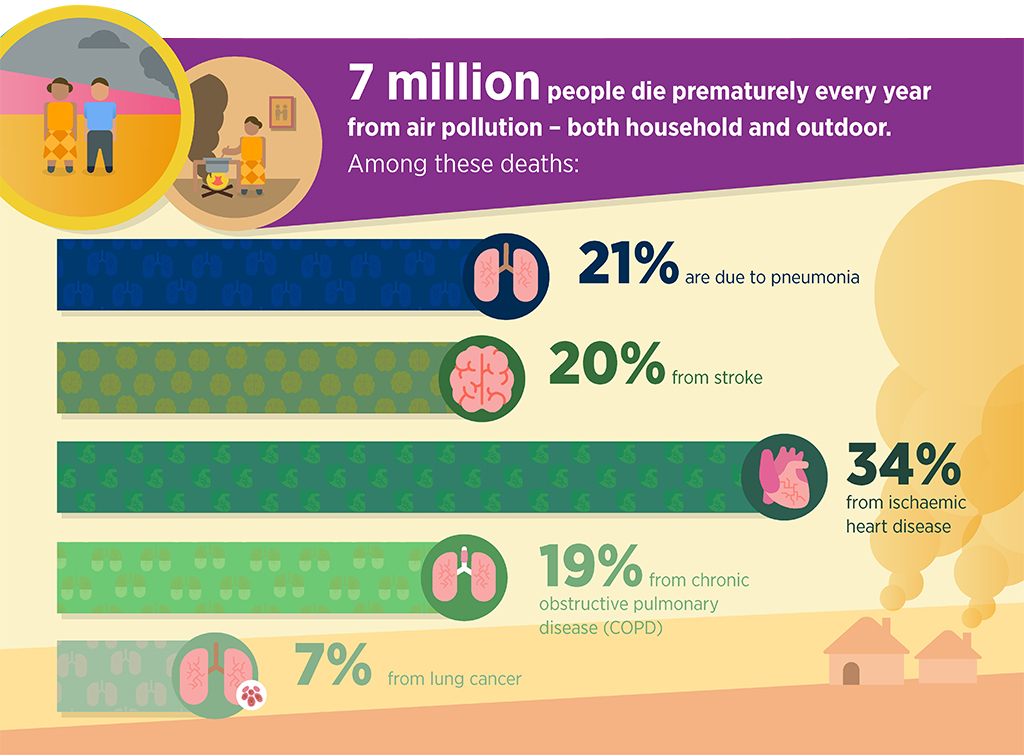Dose Reduction
Aerosolized particulate matter in the 0.1 to 2. 5-micron range (called “PM2.5”) is known to be a human health risk as it is more readily drawn deeper into our lungs where it can easily cause disease and exacerbate medical conditions2. PM 2.5 is one of the key factors in the severity of SARS-CoV-2 cases and mortality rates and in fact, one of the leading causes of death, representing over 7 million premature deaths per year.

The importance of understanding the impact that PM 2.5 has on our overall health cannot go unnoticed and needs to be considered when looking into mitigation solutions for your facility. Point being, mitigation plans needs to be looked at as a long-term solution. While we are consumed with finding ways to reduce transmission rates of Covid-19, we also have to look at the overall indoor air quality issues (IAQ). The Halo P and C are air purification stations that are not to be seen as a disposable solution but rather a permanent infrastructure improvement.
Independent particulate testing reveals the benefits of ceiling-mounted HEPA filtration at the room level: up to 74% reduction of dosage in real world application4. As shown in Table 1 below, particle levels generated while talking in an office space of 261 Ft2 areas were monitored for 50 minutes continuously to establish a cumulative baseline dose (dose = concentration X time). The testing was then repeated, this time with the Halo-P running and filtering the air inside the space. The results are impressive: with Halo-P running, the PM2.5 dose is reduced by 62% to 74%, depending upon particle size.

Figure 1 – Particle counts of baseline plus speaking aerosols, with and without Halo-P filtration. Image Credit: 3Flow
While we all desire a 100% reduction in particles (risk), no system or solution can provide an absolute guarantee of capturing all viral load from the air we breathe inside buildings. However, the 74% reduction in dose needs to be put in context to understand how impressive this truly is:
- The use of seat belts in automobiles is attributed to a 45 to 50% reduction in fatalities5.
- Airbags, used in conjunction with seat belts, reduces fatality by 61%6.
- Law enforcement body armor reduces fatality risk by 3. 4X, but does not eliminate it7.
- Annual influenza vaccines reduce illness by an estimated 40 to 60%8.
Improving Ventilation Effectiveness
With its built-in fan and two-way diffuser design, Halo-P delivers filtered room air in a circulating pattern not unlike a ceiling fan’s. Air is drawn up into the center of the Halo-P, through its layers of filtration and exhausted out through small ports on both long sides. The clean exhaust air moves along the underside of the ceiling via a slight Coandă effect and eventually cascades back down into the space at low velocities. This intake and exhaust port arrangement prohibits short-circuiting, leading to an increase in Ventilation Effectiveness (VEFF) as shown in Table 2 below. VEFF tests were conducted in the same test space, and Halo-P provided a 27% improvement over the standard ventilation design. Without Halo-P running, the VEFF was 1.26 and with Halo-P, the VEFF improved to 0.94 (note: VEFF of 1.00 = a well-mixed room, ventilating per design).

Figure 2 – Plot of aggregate average concentrations for
air samples and theoretical concentrations for a wellmixed
room at 2 ACH with and without Halo-P. Image
Credit: 3Flow
There are many benefits from improved VEFF, including quicker removal of contaminants, less or no ‘dead spots’ within the space and improved overall comfort of occupants. By improving VEFF and adding HEPA H14 filtration, the main benefit reduces risk through reduced dose. The VEFF improvement by using Halo-P is approximately equivalent to increasing the ventilation air exchange rate by 2 Air Changes per Hour (ACH) 4.
In conclusion, when considering your mitigation options, select the one that is tested and proven to provide the greatest benefit while also providing the lowest operating costs: Halo-P. See comparison chart below for a side-by-side review of the many benefits of Halo-P.

References:
1) NASA/TM—2016–218224, Submicron and Nanoparticulate Matter Removal by HEPA-Rated Media Filters and Packed Beds of Granular Materials
2) EPA,
https://www.epa.gov/pm-pollution/health-and-environmental-effects-particulate-matterpm
3) ASHRAE Building Readiness Guide:
https://www.ashrae.org/file%20library/technical%20resources/covid-19/ashrae-buildingreadiness.pdf
4) Erlab Halo-P Air Purifier Filtration Test Report, 3Flow, September 28, 2020
5) https://www.nhtsa.gov/risky-driving/seat-belts
6) NHTSA, Occupant Protection in Passenger Vehicles, February, 2017
7) LaTourrette, T., “The Life-Saving Effectiveness of Body Armor for Police Officers,” Journal of Occupational and Environmental Hygiene 7(10), 2010.
8) CDC, https://www.cdc.gov/flu/vaccines-work/vaccineeffect.htm
9) Rim and Novoselac, Ventilation effectiveness as an indicator of occupant exposure to particles
from indoor sources. Department of Civil, Architectural, and Environmental Engineering, The University of Texas at Austin, November, 2009
10) 50 Watts, $0.12/kWh, 24 hours per day = $52.60/year electricity operating cost.
11) Electricity costs plus replacement filter costs = ($52.60/365) + ($620/365*5) = $0.48 per day total operating costs.



